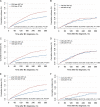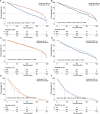Risk and prognosis of second cutaneous melanoma after radiotherapy for breast cancer: A population-based analysis
- PMID: 38197802
- PMCID: PMC11293226
- DOI: 10.17305/bb.2023.10029
Risk and prognosis of second cutaneous melanoma after radiotherapy for breast cancer: A population-based analysis
Abstract
Radiation therapy (RT), a primary treatment for breast cancer (BC), may be associated with increased non-BC tumor risk. We aimed to examine second cutaneous melanoma (SCM) risk in BC patients who underwent RT and to assess their survival outcomes. Data from 520,977 BC patients diagnosed between 1973-2018 were collected from the Surveillance, Epidemiology, and End Results (SEER) database. Cumulative SCM incidence was estimated using the Fine-Gray competing risk model. Poisson regression analysis was conducted to calculate the standardized incidence ratio (SIR) and estimate the SCM relative risk in patients who underwent RT compared to those who did not. Overall survival (OS) and cancer-specific survival (CSS) were assessed using the Kaplan‒Meier method. Among the 520,977 BC patients, 243,676 (46.8%) underwent surgery and RT, while 277,301 (53.2%) only underwent surgery. Our results suggest that BC patients receiving RT had a higher SCM risk than those who did not (hazard ratio [HR] 1.40; 95% confidence interval [CI] 1.30-1.51; P < 0.001). SCM incidence was also higher in BC patients treated with RT than in the general US population (SIR 1.12; 95% CI 1.05-1.19; P < 0.05). However, SCM patients who received RT had a significantly higher 10-year survival rate than those who did not receive RT (14.90% vs 5.94%; P < 0.001). No significant difference was found in 10-year OS or 5-year CSS between SCM following RT and only primary cutaneous melanoma (OPCM), but SCM patients who did not receive RT had a significantly lower 10-year OS, with no significant difference in CSS. This study suggests an increased SCM likelihood in BC patients due to RT, although the overall risk is minimal.
Conflict of interest statement
Conflicts of interest: Authors declare no conflicts of interest.
Figures




Similar articles
-
Risk and prognosis of secondary esophagus cancer after radiotherapy for breast cancer.Sci Rep. 2023 Mar 9;13(1):3968. doi: 10.1038/s41598-023-30812-8. Sci Rep. 2023. PMID: 36894590 Free PMC article.
-
Radiotherapy and increased risk of second primary cancers in breast cancer survivors: An epidemiological and large cohort study.Breast. 2024 Dec;78:103824. doi: 10.1016/j.breast.2024.103824. Epub 2024 Oct 19. Breast. 2024. PMID: 39442313 Free PMC article.
-
The impact of age at the time of radiotherapy for localized prostate cancer on the development of second primary malignancies.Urol Oncol. 2018 Nov;36(11):500.e11-500.e19. doi: 10.1016/j.urolonc.2018.06.007. Epub 2018 Sep 21. Urol Oncol. 2018. PMID: 30249519
-
Malignant melanoma and other second cutaneous malignancies in cutaneous T-cell lymphoma. The influence of additional therapy after total skin electron beam radiation.Arch Dermatol. 1995 Apr;131(4):432-5. Arch Dermatol. 1995. PMID: 7726585 Review.
-
Epidemiological and genetic insights into the co-occurrence of cutaneous melanoma and hematologic malignancies: A meta-analytic review.Leuk Res. 2024 Dec;147:107610. doi: 10.1016/j.leukres.2024.107610. Epub 2024 Oct 26. Leuk Res. 2024. PMID: 39476615 Review.
References
-
- Siegel RL, Miller KD, Wagle NS, Jemal A. Cancer statistics, 2023. CA Cancer J Clin. 2023;73(1):17–48. https://doi.org/10.3322/caac.21763. - PubMed
-
- Allemani C, Matsuda T, Di Carlo V, Harewood R, Matz M, Nikšić M, et al. Global surveillance of trends in cancer survival 2000-14 (CONCORD-3): analysis of individual records for 37513025 patients diagnosed with one of 18 cancers from 322 population-based registries in 71 countries. Lancet. 2018;391(10125):1023–75. https://doi.org/10.1016/S0140-6736(17)33326-3. - PMC - PubMed
-
- Smolarz B, Nowak AZ, Romanowicz H. Breast cancer-epidemiology, classification, pathogenesis and treatment (review of literature) Cancers (Basel) 2022;14(10):2569. https://doi.org/10.3390/cancers14102569. - PMC - PubMed
-
- Akbari ME, Akbari A, Khayamzadeh M, Salmanian R, Akbari M. Ten-year survival of breast cancer in Iran: a national study (retrospective cohort study) Breast Care (Basel) 2023;18(1):12–21. https://doi.org/10.1159/000526746. - PMC - PubMed
-
- Land CE, Tokunaga M, Koyama K, Soda M, Preston DL, Nishimori I, et al. Incidence of female breast cancer among atomic bomb survivors, Hiroshima and Nagasaki, 1950–1990. Radiat Res. 2003;160(6):707–17. https://doi.org/10.1667/rr3082. - PubMed

